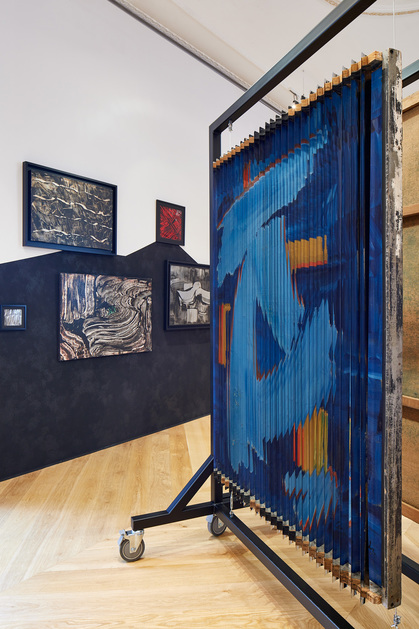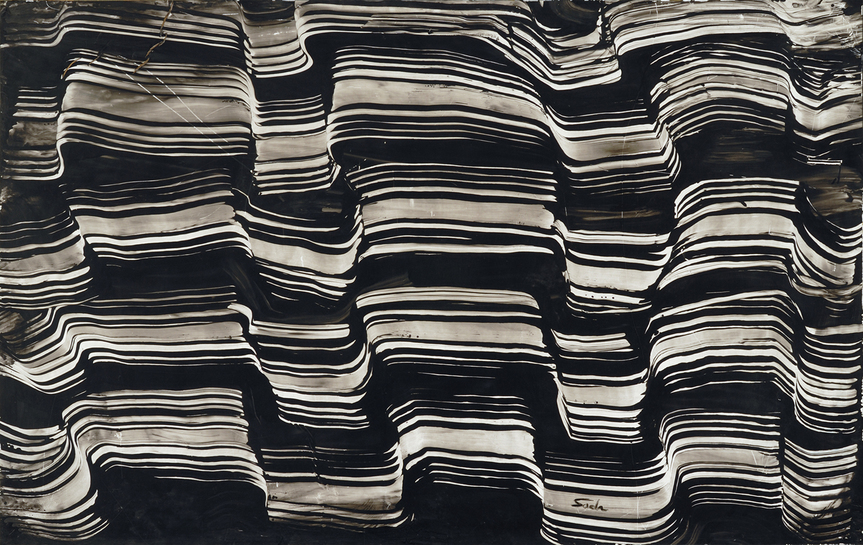-
From Current Issue
-
- Editor’s Letter Fire in the Heart
- Reviews I Gusti Ayu Kadek Murniasih
- Reviews 11th Seoul Mediacity Biennale: “One Escape at a Time”
- Dispatch Networked China
- One on One Monira Al Qadiri on Yukio Mishima
- Essays The rise of independent art spaces in pandemic-era Shanghai
- Features Tuan Andrew Nguyen
- Table of Contents
- Web Exclusives
- Archive
- Subscribe

R
E
V N
E
X
T
Installation view of BEHJAT SADR’s “Dusted Waters” at The Mosaic Rooms, London, 2018. Photograph by Andy Stagg. All images courtesy The Mosaic Rooms.
Behjat Sadr lived a life of exile and incessant relocation, as the first major presentation of her work in the United Kingdom, “Dusted Waters” at London’s Mosaic Rooms, emphasizes. The exhibition moves through three locations that were instrumental to transformations in her practice. Taking as its starting point her initial encounter with modernism in Italy in 1955 whilst studying at the Accademia di Belle Arti in Rome, the departure into her time in Tehran and Paris could be accused of over-selling her context.
Installation view of BEHJAT SADR’s “Dusted Waters” at The Mosaic Rooms, London, 2018. Photograph by Andy Stagg.
The opening room presents a dispersed chronicle of Sadr’s move from the Faculty of Fine Arts at the University of Tehran to her time in Italy. Archival photographs, newspaper reviews related to her participation in the 31st Venice Biennale in 1962, postcards, exhibition catalogues, and letters jostle with each other on the walls, almost obscuring a series of her handwritten quotes and poetry extracts, which punctuate these constellations of material. Among this archival splurge, Sadr’s early works struggle to be seen, and although two Untitled abstract paintings with thick vibrant markings from 1956 are hung on sections of colored wall, presumably to highlight their significance, their intense tactility and viscous markings are lost, serving more as a distraction from another cluster of material and a film by Sadr’s close friend, the Iranian filmmaker and poet Forough Farrokhzad. From this composite of archival material and a single black ink drawing titled Forough’s Corpse (1967) that Sadr produced after the poet’s death, a picture of her artistic concerns around “blackness” and physical elements begins to emerge. Both the artist and Farrokhzad found emotional refuge and expressive potential in this shade, often viewing the natural world through a darkened lens. Sadr articulates this in her own poetry, noting, for example, “The blackness of lines lying in water.”
These interests coalesce in the works presented from Sadr’s move back to Tehran in the 1960s. At a time of growing nationalism preceding the 1979 Revolution, Sadr worked hard to develop an abstract style with a minimal use of color that transcended the political circumstances in Iran. Several freestanding metal frames, holding within them aluminum canvases, and raised from the ground by legs with castors, stand firm in the center of the gallery. These three Untitled pieces—one from 1974 and two from 1967—that incorporate slats from Venetians blinds comprise her kinetic works, which, as texts abstracted from her diary running across the gallery wall attest, were a proud innovation of this period, giving visual currency to her compulsion to experiment with motion. In the works from 1967, the vertically arranged sections of blind superimpose geometric regularity upon her exuberant paint strokes, created, as a nearby video projection shows, by scraping oil paint rigorously and repetitively with a palette knife across the surface.
Sadr’s use of this viscous medium in her signature color, black, makes references to Iran’s expanding oil industry during this period. In the numerous works hung in salon-style groups, the paint possesses an agility of its own and, as in Untitled (1974), as if liberated from the canvas, it seems to ooze and slide across the wall. This organic movement of spills and splatters finds its counterpoint in a series of more contained oil landscapes informed by Sadr’s photographic documentation of Iran’s oil infrastructures, displayed in a plan chest in the corner of the gallery. In Untitled (1976), Untitled (1974–75) and Untitled (circa mid-1970s) a series of tower-block formations make observations about the rapid accumulation of wealth and consequential modernization of Iran stimulated by oil.
It would appear from the exhibition’s chronological arrangement of Sadr’s work that architecture and environment became an increased reference point for the artist. Photopaintings constructed towards the end of Sadr’s career converge her characteristic palette-knife painting with her photographic documentation of landscapes in Iran, Italy and Paris. Presented as table-tops on wooden, school-desk structures, these works fixate on her experiences of the natural environment. In Untitled (1986), large boulders are compressed within a frame of her paint strokes, while Untitled (1985) attempts to trap photos of lofty green trees, fitting with the exhibition’s focal narrative of Sadr’s enduring need to reconcile herself with her surroundings.
Behjat Sadr’s “Dusted Waters” is on view at The Mosaic Rooms, London, until December 8, 2018.
To read more of ArtAsiaPacific’s articles, visit our Digital Library.
















